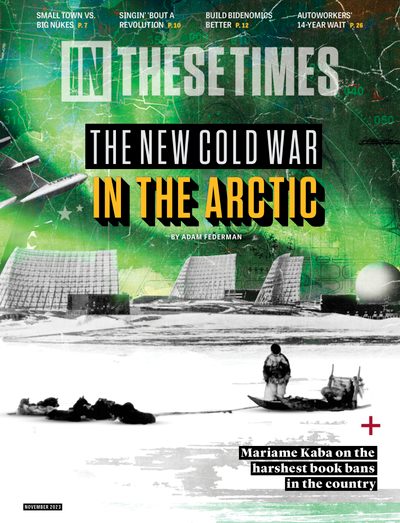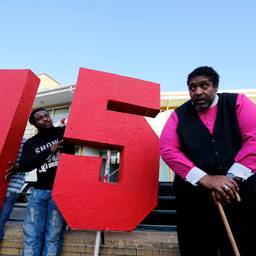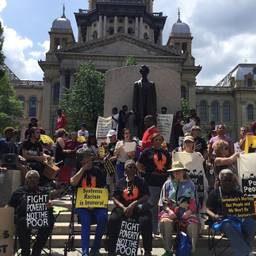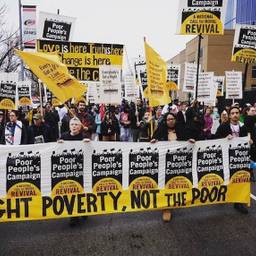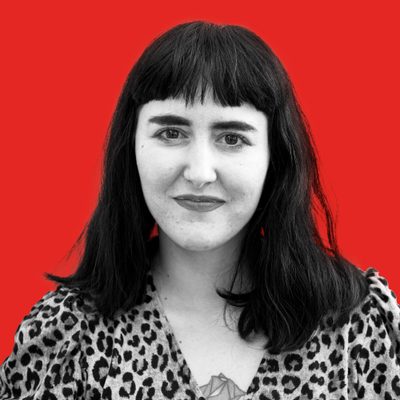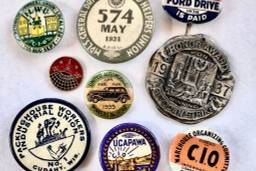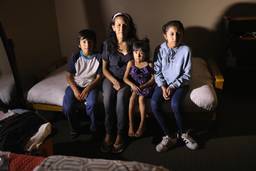Striking a Chord for Change: The Poor People’s Campaign for Revolution
In an effort to record their first album of movement songs, the New York State chapter of the Poor People’s Campaign is tapping into an old organizing tradition with hopes of inspiring change.
Natascha Elena Uhlmann

OSSINING, N.Y. — Miriam, age 6, plays the drums, first cautiously, then with vigor. Around her, a mic stand is assembled, cables are untangled and a sound check begins. She sets the drumsticks down, then runs on stage, attempting cartwheels with her younger sister.
A cluster of voices warms up and melds into harmony: Well I went down to the rich man’s house / And I took back what he stole from me.
One of the vocalists, Jamel Coy Hudson, beams: “I hope you caught that. I felt it in my big toe.”
Miriam and her sister erupt in applause. The singing resumes. A latecomer arrives and is urged to join. Joy is the order of the day, enveloped with a fellowship so warm and attuned it seems it must be fostered through the certainty that your cause is just, that you can win.
I’m at a workshop with roughly 20 organizers from the New York State chapter of the Poor People’s Campaign (PPC), who’ve gathered to record their first album of movement songs.
Since its founding, in 2018, as a revival of one of Martin Luther King Jr.’s last calls to action, the PPC has endeavored to fight “the evils of systemic racism, poverty, ecological devastation, and the war economy and militarism.” It has organized actions nationwide in an attempt to mobilize the 140 million poor people in the world’s wealthiest country.
With music, the movement is turning to a new — or perhaps old— organizing medium.
“Art and culture are used all around us to perpetuate the way things are,” Charon Hribar explains, between recording a vocal track and laying out lunch. Hribar is director of cultural strategies for the Kairos Center — one of the PPC’s “anchor organizations”— as well as co-director of the PPC’s cultural arts team. Both positions underscore how integral art is to the movement, which in 2020 compiled its own songbook. “We need to be able to create our own music and visual arts that tell our message,” she continues. “It helps ground us and connects us to this history of struggle, by teaching songs that come from before us, and recreating them for this moment.”
For generations, popular movements have used music to decry injustice, from ballads about wicked coal barons to Trini Lopez’s unforgettable rendition of “If I Had a Hammer,” to Nina Simone’s devastating “Mississippi Goddam.” The tradition continues today, as with SPELLLING’s “Haunted Water,” which intertwines the brutality of the Middle Passage with the desperation of present-day refugees crossing the Mediterranean, or Los Tigres del Norte’s “Somos Más Americanos,” which reminds listeners, “I did not cross the border, the border crossed me.”
“Artists understand the role of culture in the struggle for liberation,” says Hudson, tri-chair of the New York PPC. While much of mainstream culture is exploitative — “based in a capitalistic society that takes the art of Black people” — he explains that “we’re reclaiming and making it clear that this art belongs to poor people, to those who have the blues.”
It’s a tall order. If a budget is a moral document, a report is a confession, and Gov. Kathy Hochul’s 276-page State of the State report uses the word “poor” just three times — and then only to refer to concepts like New Yorkers’ “poor user experience” in accessing government websites.
The state PPC responded with its own report, as well as a music video, “Face of the State,” compiling stories from New Yorkers struggling under poverty, unemployment, addiction and state violence. “For two years, I had to live in a tent,” one woman says in the video. “I’m 71, and I shouldn’t be looking for another job,” adds another. It’s a jarring portrait of a state that has let capitalism chew communities up.
But movement music has more than one purpose. For weeks after the retreat, one melody stayed with me: “Up Over My Head,” with origins in a 19th century hymnal that was adapted by Bernice Johnson Reagon, a founding member of the Student Nonviolent Coordinating Committee (SNCC), and later recorded by activist Bettie Mae Fikes, a member of the SNCC Freedom Singers. The song is legendary in movement spaces. As Hribar explains, its original lyrics were a warning: “Up over my head, I see trouble in the air.” But “even though she knew they were in hard times,” Reagon saw the struggle needed “something more powerful, and she started to transform those words” into a mantra of hope: “Over my head, I see freedom in the air.”
The mere act of singing can help movements endure, argues Paul Engler, founding director of the Center for the Working Poor. Against a culture of individualism, movement music strengthens bonds and prioritizes joy as a cornerstone of activism. “The beauty of group singing is that no one person has to be particularly good,” Engler writes. “People just have to be willing to open their mouths and sing.”
It’s a principle the PPC organizers take to heart. “We have a lot of talented artists who have different gifts,” Hudson says. “But the intent is always to lift up and have joy over our head, and liberation and freedom at the forefront of why we do what we do.”
Natascha Elena Uhlmann is a staff writer at Labor Notes.
